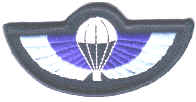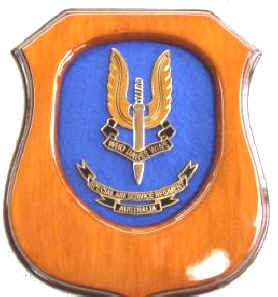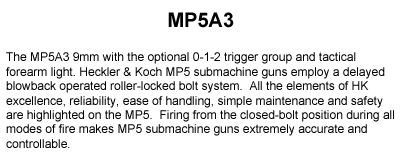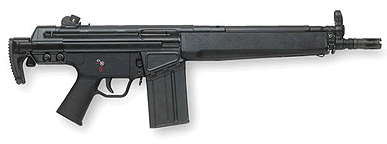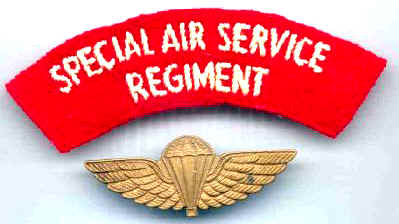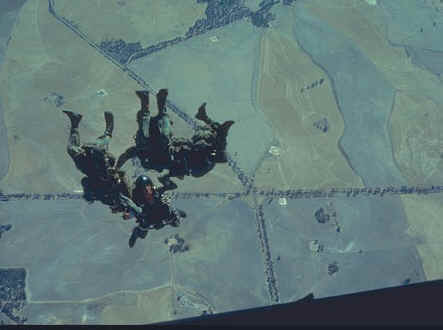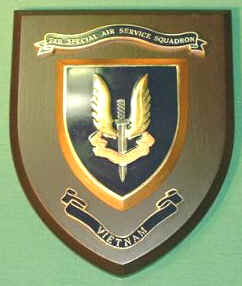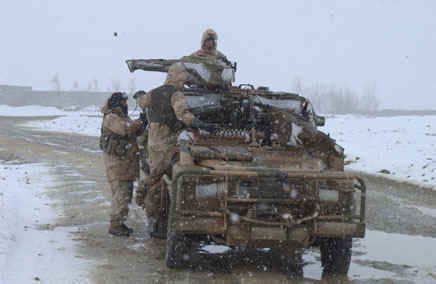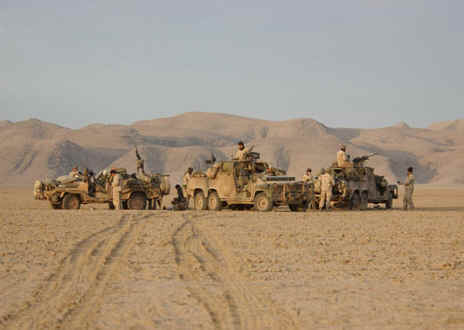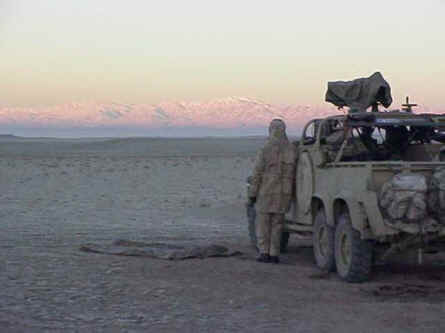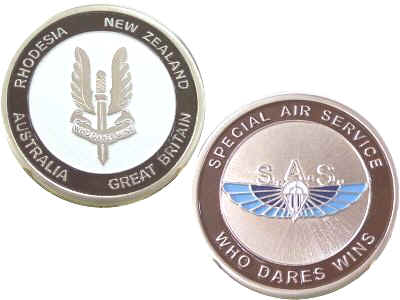 |
|
|
|
 |
Special Air Service Regiment |
|
|
Motto: Who Dares Wins
|
||
|
SASR formerly SAS |
Copyright (part) 1995-2000 SpecWarNet |
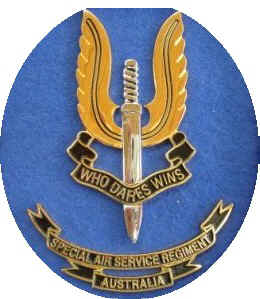 |
|
 |
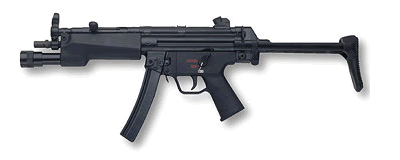
|
| Originally SAS wore a red beret to indicate their parachute role but now wear sand as shown. |
|
|
|
|
The history of Australia's "Special Forces" can be traced as far back as the 1940s when Australian soldiers were part in AIB or Allied Intelligence Bureau. However it wasn't until July 25th, 1957, when the Army turned to Major W. Gook, that a proper "Special Forces" unit was formed. Major Gook was put in charge of a new unit: the 1st Special Air Service Company (Royal Australian Regiment). The total strength of the Company was only180 men at first. On August 20th, 1964, the SAS finally became a full Regiment consisting of three "Sabre" Squadrons, a Training Squadron, and a Headquarters. The SASR was modelled after the British SAS. The SAS had previously worn a red beret (indicating them as a Parachute Company) with the Infantry Corps Cap Badge. In 1966, the SAS was given permission to change over to the beige (sand) beret. However since most of the SASR was deployed to Borneo at the time, all they could get were the British SAS berets with the cloth Winged Dagger emblem on them. Later on that year the cloth patch was replaced by a black flash and a solid gold metal Winged Dagger emblem on top of it.
The SASR was first deployed to Brunei in 1965. It was 1 Squadron and would also be the first to see active duty. Later on in that same year 1 Squadron would also be deployed to Borneo. The British had already been in Borneo for some time. The first request by the British Government for Australian SASR help was declined. However, as the "conflict" grew the SASR was brought in. The SASR was tasked with stopping the communist Indonesian troops from taking over Borneo. They often worked along side their British and New Zealand counterparts. The conflict of Borneo was a tough one for Australian troops. They soon found themselves living in the jungle, sometimes on patrols for months. They learned how to track the enemy, lay ambushes, and defeat him at his own games. This would prove effective again later in Vietnam. Another way the SASR defeated the enemy was to win the "hearts and minds" of locals. The local tribesmen would usually help in any way they could, and the SASR provided needed repairs, medical treatments, and food for the villagers. This was to prove very affective. The main threat came from a group known as RPKAD. The RPKAD were known for being extremely brutal. They wore a cap badge which depicted a set of Airborne Wings with a dagger through them on top of an octagon. The RPKAD were usually noticed because of this cap badge. The RPKAD is the forerunner to today's KOPASSUS (read below for more recent information). The war lasted until 1966. Three SASR men died while on active service in Borneo, however none died from direct enemy contacts.
They did however use captured VC (Viet Cong) and NVA (North Vietnam Army Regulars) to help them locate the enemy. The SASR soon started operating with American SEAL (SEa-Air-Land) Teams and Special Forces. The SASR also helped with the American Recondo School and with MAC-V-SOG missions. The Recondo School was started in Australia, and the principles were passed on to the Americans. The Patrol Course the SASR runs today is similar to that of the Recondo School. The bond between the SASR and the different American Special Operations units is still strong today. The SASR fought this war in Vietnam until 1971. 4 SASR soldiers died during accidents, one died months later from gun shot wounds received, and one is still MIA (although now presumed dead).
In 1991 a small team of Australian SAS soldiers returned to Cambodia (an area where in the 1960s and 70s the SASR had operated in against them). It was a UN team sent in to help make peace between the Cambodian people. They did several other tasks such as mine clearing, guarding ancient monuments (which were favourite targets of the enemy), gave medical aid, made repairs, and other such tasks. The first group consisted of 8 SASR soldiers, more came later. SASR Soldiers also took part as observers in other parts of the world ranging from India to Lebanon to Sinai. These missions usually went without much action. Some SASR soldiers also signed up for the Rhodesian SAS (no longer in existence) during the mid 1970s. These men may have been on leave or may have already left the SASR but were still looking for action. Many were vets of the Borneo and Vietnam Wars. The Australian Government did not condone this. The SASR was called up again 1994. They were being sent to Somalia, a small African country. It was called Operation Iguana. It was J Troop, 3 Squadron who was called. The men had several tasks:
These were just a few of their tasks. The men soon earned the nickname "Gerbils". During a Mobile Patrol, a group of Somali men raised their weapons at the patrol and took aim. Before they could squeeze the trigger a young trooper shot off a three round burst from his Minimi 5.56 Machine Gun and killed two instantly. This was the first "Official" kill since Vietnam.
In 1994 and 1995 the SASR was sent to Rwanda to help the UN. Their job was to provide medical aid to the sick and wounded. Thousands of refugees were seeking help. The skilled SASR medics soon proved their worth. They saved hundreds of lives. One man, Jon Church, stood out amongst them. He was a dedicated soldier and good medic. Sadly soon after returning to Australia he would die in the Blackhawk helicopter crash on June 12th 1996. The SASR is rumoured to have taken part in the 1991 Gulf War. It is known that several members were "attached" to 22 SAS. However rumours have surfaced that the SASR also acted independently. In 1998 110 members of the SASR and the NZ SAS were again called up when Saddam threatened more violence. They were deployed, but their roles are still a secret. The SASR suffered a hard blow in 1996. 1 Squadron was preparing for a CT exercise. They boarded two Blackhawk Helicopters. During the flight, the helicopters collided killing 15 members of the Regiment. These men died during training, training that was is as close to the real thing as it can be. These men died doing what they wanted to do. They died as members of the Special Air Service Regiment. Most recently the SASR was deployed to East Timor (1999). The SASR is tasked with VIP Protection, LRRP jobs, and manning Op posts. The main enemy in this conflict was the Indonesian Government, and more specifically the KOPASSUS. The KOPSASSUS are directly related to the RPKAD of the Borneo conflict. They have trained with the Australian SASR and the American Special Forces and SEALs. Now they are accused of horrible war crimes. The SASR was also responsible for surveying beaches with the Australian Clearance Divers. Two soldiers are also rumoured to have been wounded in a shoot out with several militia men.
SASR troops are actually on call up for the 2000 Olympic Games in Sydney. The troops have been preparing for this since 1997. The soldiers have done full scale hostage rescue exercises among other things. Needless to say, if anything does happen; the SASR will be the first in. The SASR has been involved many other operations we may never know about. However they are their, behind the scenes. The SASR has, for many years, been involved in VIP Protection in Australia and abroad. Many of these operations go unnoticed but the SASR is there.
Selection for the SASR was held on the Stirling Ranges. These were selected to test the students endurance and mental stamina. They shared many of the same qualities as the Brecon Beacons in Wales (home of British SAS Selection). The Stirling Ranges were used until 1990 when they were shut down by the Australian Government. An outbreak of Die Back, or "the Greenies", was the cause of this. Some of the climbing is still taught in the Stirling Ranges, but this must be monitored so that no one turns up sick. Selection for the SASR is tough. Fewer than 10% will ever make it. A new rule has been added recently, allowing members from every branch of the ADF (Australian Defence Force) to join the SAS. Men come from all walks of life, bored soldiers, tank drivers, mechanics, RAAF pilots, etc. Anyone may apply. After you apply, you will be sent a detailed packet. It tells you what to pack, how to work out, what Selection is like, and other helpful bits of information (somewhat similar to the BUD/S Warning Order). Selection is now held in the Pokolbin Ranges and run from Singleton. The course hosts members of the Army trying to join either the Commandos or the SASR. After three weeks candidates who are fit for the Commandos will leave the class behind for their own training, while SASR Candidates still have another three weeks of Selection left. After this they are in for 12 months of continuous training. If you fail one course you are RTU'd (Returned To Unit) on the spot. So don't fail. Courses include:
The first counter terrorist unit formed by the SASR was actually a unit that already existed. 1 Squadron picked up the CT task in the late 70's until 1978 when the Australian government said they needed a full time CT unit. Again the Army turned to the SASR. This time they created a new "sub-unit" called TAG. TAG, or Tactical Assault Group, is formed from members of the SASR (such as Delta is formed from Army SpecOps personnel). In the beginning each group was broken down by Land (Gaunlet Teams) or Water (Nulla Teams). Each year they would be called a new number (ie Gaunlet 1, 2, and 3). After TAG was formed it was found that they needed to reorganize the men. While one troop was ready to deploy on a moments notice, the two other troops would be off training. In 1980 the Australian Government insisted on a maritime unit that was able to retake oil rigs in the Bass Strait. This new unit was called OAG (Offshore Installations Group). It is very similar to DevGru and the two train together often. The TAG needed more people to help support this new role. A small group from the Australian Navy's Clearance Divers unit transferred over the SASR to help bolster the ranks for the OAG. Many members of the SASR did not like the idea that the Diver just entered the Regiment without taking Selection, so to make them happy each diver had to undertake SASR Selection and had to become parachute qualified. The unit was later changed to OAT (Offshore Assault Team). As their name states they are responsible for any terrorist activities around the water. They learn to assault ships, oil rigs, small boat, and other potential targets. To join the TAG/OAT one must first be
in the SASR. After a soldier has completed two years on a regular Sabre
Squadron, he may then put in for TAG/OAT. If excepted he will have to
undergo further training. All TAG/OAT operatives are HALO and HAHO
qualified. They must be proficient in the ways the TAG/OAT work. The CT facilities
are incredible. Including full scall building mock-ups and a huge
Killing Village. Airplanes and buses are also found there. No money is
spared on training for these soldiers.
The SASR also favours the Minimi. It is pretty much the same as the American SAW or Squad Automatic Weapon). It can be fired from a belt, 30 round magazine, or a 200 round drum. The Minimi fires a 5.56mm round, the same round as the M-4. This makes the magazines interchangeable. The M-60, 7.62 light machine gun is also in use. This weapon was first used in Vietnam. It was also the standard light machine gun issued to US Armed Forces at the time. The SASR uses the full range of H&K sub machine guns. From the MP-5 to the G-3. see above. These weapons are mainly used by the TAG and OAT members, although they can be used by others or specific missions. The SASR use a 6x6 extended wheel based Land Rover 110 as their primary vehicle. The truck is a one of kind. The Land Rover can be fitted with a mixture of .50 Machine Guns, Mk19 40mm grenade launcher, or GPMG (General Purpose Machine Gun). |
